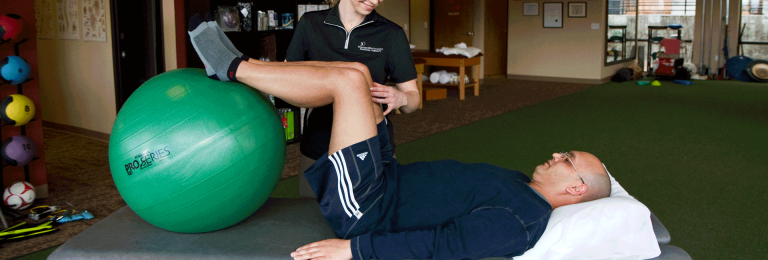A pelvic health physical therapy visit can be important for anyone experiencing pain or discomfort in the pelvic region. When dealing with pelvic floor discomfort, dysfunction or disorder, a pelvic health physical therapist can help you regain physical function, alleviate pain and improve your quality of life. Although pelvic pain and dysfunction is more prevalent in women, it is a common condition for men. For example, male incontinence is common, but it is not normal, and it is treatable.
Many men are initially skeptical about having a PT appointment for their pelvic issues. However, male pelvic floor dysfunction is often musculoskeletal in nature – with pelvic floor muscles that may be tight, weak or injured – meaning physical therapy is the best option for treatment since PTs are musculoskeletal experts!
Specialized physical therapists are educated and trained to assess the muscles and joints in the pelvic region for both women and men and to create custom plans to address pelvic floor dysfunction.

Examples of male pelvic floor dysfunction or disorder include:
- Incontinence
- Urinary urgency incontinence / frequent urination or overactive bladder
- Urinary stress incontinence
- Bowel incontinence / fecal incontinence
- Constipation
- Erectile dysfunction (ED) / sexual dysfunction
- Pain
- Testicular pain / genital pain
- Pelvic pain / groin pain
- Low back pain
- Pain with intercourse
Physical therapists approach men’s pelvic health visits just like any other PT visit. Let’s explore what a typical Men’s Health Physical Therapy visit might look like.
- Interview:
PTs start all initial visits with a thorough interview to get a better idea of the symptoms, onset, complicating factors, and history of the problem. We will also build goals for this specific episode of physical therapy. This interview may be the most important part of the initial visit since the information learned here will often guide what is done in the physical exam.
- Examination:
The hands-on portion of a visit will start by evaluating overall health and physical condition, with a focus on the pelvic region. This may involve a comprehensive physical exam, an assessment of posture and movement patterns, and tests to determine the range of motion and strength in the hips and lumbar spine.
Pelvic pain and dysfunction are often the result of issues in the lumbar and sacral regions, abnormal breathing or stabilization patterns, or muscular tension. For that reason, the PT may need to palpate the abdomen, lumbar and sacral areas, and pelvic floor muscles. These findings not only illuminate conditions such as pubic symphysis disorder, but they provide the PT with critical information with which they build an individualized plan of care.
- Development of a Treatment Plan:
Based on the examination and discussion of goals, the PT will develop a customized treatment plan. This plan may include exercises, stretches, manual therapy techniques, and other interventions aimed at reaching the goals established in the interview. Quite often, in pelvic health PT, education about anatomy and abdominal biomechanics is a crucial portion of the treatment plan.
- Home Exercise Program:
In order to maintain or build upon the progress achieved while working with the PT in the clinic, a home exercise plan (HEP) is always provided. Though the famous Kegel exercises will likely be included in a treatment plan, there are many muscles that make up the pelvic floor, all of which need to function properly to overcome pelvic floor dysfunction.
Your HEP will include exercises and stretches that can be performed independently and will complement the activities performed during the physical therapy visit. Although it is sometimes difficult to be consistent with the HEP, patients are most likely to meet their goals when they regularly perform the HEP as instructed.
Overall, a pelvic health physical therapy visit is a valuable experience for anyone experiencing pain or dysfunction in the pelvic region. With the help of a skilled and knowledgeable physical therapist, patients can expect to see progress toward their goals, feel better, and lead a more active, pain-free life!


Start your physical therapy journey today.
Our professional and caring staff have specialized training to meet the unique needs of all individuals throughout their lifespan. Through education, manual therapy, biofeedback and exercise, our goal is to improve your function, decrease your pain, and guide you on your personal path to improved health and wellness.


